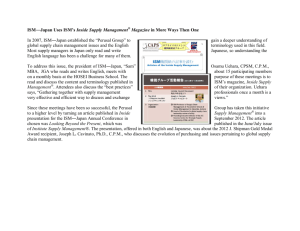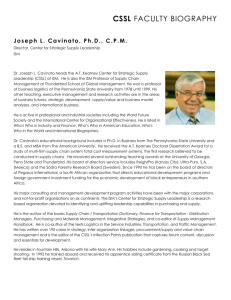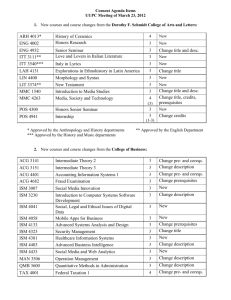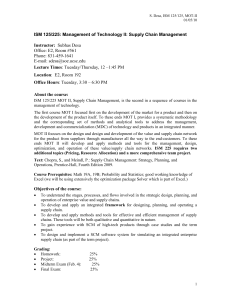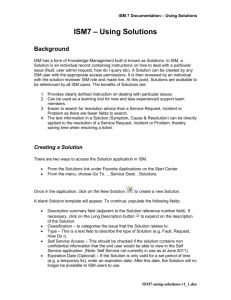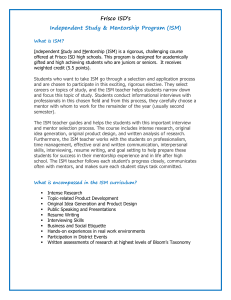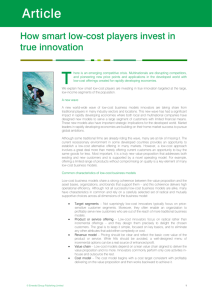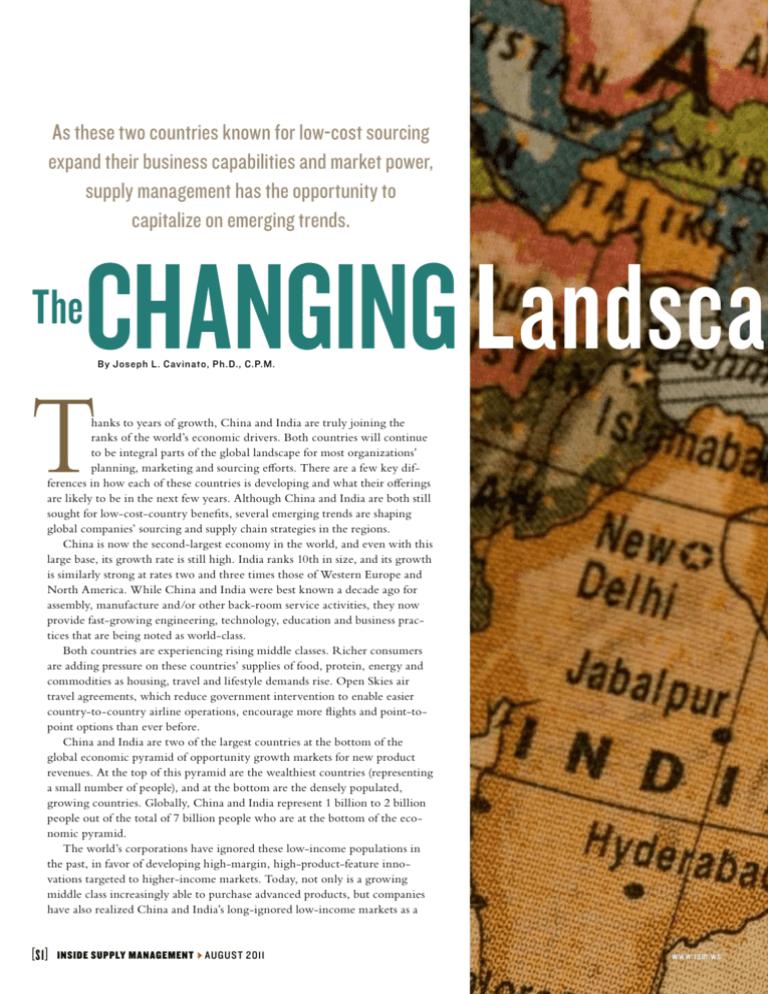
As these two countries known for low-cost sourcing
expand their business capabilities and market power,
supply management has the opportunity to
capitalize on emerging trends.
The
Changing Landsca
T
By Joseph L. Cavinato, Ph.D., C.P.M.
hanks to years of growth, China and India are truly joining the
ranks of the world’s economic drivers. Both countries will continue
to be integral parts of the global landscape for most organizations’
planning, marketing and sourcing efforts. There are a few key differences in how each of these countries is developing and what their offerings
are likely to be in the next few years. Although China and India are both still
sought for low-cost-country benefits, several emerging trends are shaping
global companies’ sourcing and supply chain strategies in the regions.
China is now the second-largest economy in the world, and even with this
large base, its growth rate is still high. India ranks 10th in size, and its growth
is similarly strong at rates two and three times those of Western Europe and
North America. While China and India were best known a decade ago for
assembly, manufacture and/or other back-room service activities, they now
provide fast-growing engineering, technology, education and business practices that are being noted as world-class.
Both countries are experiencing rising middle classes. Richer consumers
are adding pressure on these countries’ supplies of food, protein, energy and
commodities as housing, travel and lifestyle demands rise. Open Skies air
travel agreements, which reduce government intervention to enable easier
country-to-country airline operations, encourage more flights and point-topoint options than ever before.
China and India are two of the largest countries at the bottom of the
global economic pyramid of opportunity growth markets for new product
revenues. At the top of this pyramid are the wealthiest countries (representing
a small number of people), and at the bottom are the densely populated,
growing countries. Globally, China and India represent 1 billion to 2 billion
people out of the total of 7 billion people who are at the bottom of the economic pyramid.
The world’s corporations have ignored these low-income populations in
the past, in favor of developing high-margin, high-product-feature innovations targeted to higher-income markets. Today, not only is a growing
middle class increasingly able to purchase advanced products, but companies
have also realized China and India’s long-ignored low-income markets as a
[ S1 ]
Inside supply management
August 2011
www.ism.ws
pes of
China and India
www.ism.ws
August 2011 Inside supply management
[ S2 ]
The
Changing Landscapes of China and India
vast marketplace of people who will
purchase low-cost/priced and lowfeature products. For example, simple
cell phones designed to only send and
receive calls are being rolled out at
affordable prices, and while the margins
are low, this market has high-volume
potential.
Both countries are experiencing
fast-rising technology and innovation
value chains. For instance, China has
long been ideal for low-cost manufacturing, and India was known for
IT and customer-support outsourcing
opportunities, but the lines are beginning to blur between countries. China
has been moving into some services
areas and building a strong base of
English speakers, catching up on India’s
long-standing language advantage.
Indian companies are actively seeking
of the yuan continues to increase, which
is beginning to spur national inflation.
The rush is now westward and southward to locales farther from the coast
but closer to cheaper labor. This migration can be seen in the Guangdong
province along the coast, which is now
reported to have more than 10,000
empty factory buildings.
The centers of gravity for entire
industries are shifting, with two of the
most prominent being the cell phone
and computer assembly industries; this
industrial migration took place at a
faster rate than economists predicted it
would just 10 years ago. Additionally,
many Chinese companies are looking
farther to outsource or operate in
Laos, Cambodia, Myanmar and other
lower-cost countries. This means that
developed-market companies concerned
There is no one established business model that can
be exported from developed countries to China or India
and be expected to work.
manufacturing business opportunities.
The playing field for both countries is
leveling, and in the coming decade we
can expect to see business capabilities
grow more sophisticated as these markets expand.
China: An Evolving National
Landscape
Traditional growth in China
occurred along the coastal regions of
the country. These were the areas with
easy world-outlet access through the
ports of Hong Kong and Shanghai.
Today, manufacturing is quickly
spreading inland among the country’s
22 provinces. According to a June
2011 study by The Boston Consulting
Group, Chinese wages are rising at
about 17 percent per year and the value
[ S3 ]
Inside supply management
August 2011
about supply chains five, six and seven
tiers deep are facing more complex
challenges to track and assure quality
and other product attributes.
China is quickly mimicking the
United States’ industrial origins by
moving rapidly up the value chains of
most industries. With higher education
and access to technologies and investments, low-cost labor is beginning to
shift to companies that manufacture
brand products, from research and
product development stages through
the life cycle of the products.
Chinese consumer electronics and
home appliances manufacturer Haier
has done this successfully with its products in North America and Western
Europe. Supported by recent growing
demand for automobile and car-part
manufacturing built by U.S. and
European marketrs, China is poised to
become a major brand player in world
automobile brands. The next target for
the country is to do the same in commercial aircraft development and sales.
In the midst of these developments,
challenges still remain regarding honoring intellectual property. Clarity,
enforcement and resolution of intellectual property issues are often
complicated by a vast mosaic of laws,
regulations and courts at local, provincial and national levels. Quality
issues and material substitutions can
be common, thanks to a long-heldover culture in some areas from the
Communist era, focusing on producing
target output numbers above all else.
As a result, major supplier oversight
and assurance efforts are necessary in
most industries. Today, many Chinese
companies seek to improve quality and
supplier performance to gain an edge in
their quests for growth in global markets, and look to foreign companies for
customer training and supplier development methods and models.
China has also been making significant improvements to its physical
attributes as well as its business acumen.
It is the first country in almost a
hundred years to plan, invest in and
build its infrastructure in advance of
economic growth. The United States
was the only other country to do this,
beginning in the 1880s through to the
completion of the interstate highway
system in the 1970s. Most other countries experience growth first, and then
have to invest after the fact to address
the accompanying capacity shortages
of highways, airports, electricity production and more. These countries,
and their industries and societies, are
frequently saddled with higher financial
and social costs. China, on the other
hand, has been forward-looking with
its infrastructure investments, and these
improvements act to continually lower
the overall costs of manufacturing and
costs of living. This is the country’s significant competitive advantage and one
that will give it an economic edge for
many decades to come.
www.ism.ws
India: Rapid Economic
Development
India has had one early edge in
developing its outward global growth:
mastery of the English language. Each
of India’s 28 states has separate dominant
languages, but English is common across
all. Thanks largely to India’s ability to
communicate in the world’s primary
business language, its economy has
been growing at high rates in the last
two decades, and it is now the world’s
10th largest economy according to the
International Monetary Fund’s 2011
Report for Selected Countries and Subjects.
The global chase for low labor costs
focuses on India’s national technical
educational levels, development of
technologies and lower costs of readily
available global communication links.
These characteristics have given it a
worldwide edge in high-end corporate
services. Today, technologies comprise
approximately 55 percent to 60 percent
of its GDP, and this will continue to
spur enhancements in education, attraction of talent and market opportunities
for India’s businesses.
A gradual opening of retail market
participation by outside companies is
taking place in India. Long-standing
consumer product companies like
Hindustan Lever (of Unilever) have
an edge because they understand the
uniqueness of this market and the complexity of its distribution and marketing.
Bureaucracy and a wide range of
regulations are major challenges in
India. In many of its states, organizations employing 100 or more employees
that need to downsize may not lay off
employees without government permission, according to the Industrial
Disputes Act. This restriction has
generally discouraged U.S.-based companies from entering into the country
with green investment projects; instead,
companies prefer to use and develop
locally owned and operated manufacturing capacity.
In terms of infrastructure, a major
highway project is under way called
the Golden Quadrilateral, and it should
speed and lower costs of truck transportation connecting New Delhi,
Mumbai, Chennai and Kolkata. ABM
Trans-Lines Shipping and Logistics
Corporation privately operates a port
in the country, and it is widely considered to be very efficient. As Singapore
recognized many years ago, world-class
airports attract and encourage business
activity and investment. India recently
opened a US$2.2 billion world-class
terminal at the international airport in
New Delhi.
Though India is now experiencing
inflation between 8 percent and 9 percent (reported at 8.72 percent in May
2011), it will long be a viable source of
quality manufacturing at low costs as
well as a possible market for expansion.
Like China, it has the advantages of
both first- and third-world economies
all in one, meaning companies have
the opportunity to competitively sell
high-end products to richer consumers
in these countries, and sell less elaborate
products to the rest of the economic
market, as well.
The Next Horizons
There are few general statements
that can be made about the trends in
these two countries. China will not
be the only low-cost manufacturing
resource, nor India the only high-tech,
low-cost resource of the near future.
Leaders in both countries understand
the need to branch out and provide
their low-cost advantages by looking at
outsourcing options in other countries.
Both countries’ growth and middle
classes will expand their automobile
industries, bringing the attendant high
employment, development of engineering, expertise in global marketing
and further increase in foreign earnings. These new automotive-related
companies will no doubt grow into
global corporations in their own rights,
and compete with the established U.S.,
Japanese and Western European companies. As new and growing industries in
their local markets, they will have the
advantage of being able to concentrate
on new paradigms and new technologies
in the industry — a level of flexibility
not always possible for the legacy companies in established developed markets.
There is no single established business model that can be exported from
developed countries to China or India
and be expected to work. Each country’s legal system, history, culture,
markets and more require fine-tuning
regarding how companies operate,
create strategic directions, make decisions and so on. Supply management
professionals in the 1980s who were
some of the first to travel and look at
working in or outsourcing to China
and/or India were the first to understand this. The nuances — and benefits
— of working in different countries are
why outsourcing, collaboration and the
use of many forms of third-party organizations is so common today and will
continue to be in the future. It is why
supply chains are longer and more complex, and must be able to quickly morph
into different forms today based on
global market demands and limitations.
More than anything, the growth and
future directions of China and India
point to the simple fact that low-cost
labor is not the only big driver in globalization today. Low-cost labor now
shifts geographies in as few as five years.
Instead, successful globalization of
sources, as well as product and services
sourcing, requires constant balance and
flexibility in total costs of labor, currency levels, interest rates, technology
and skills bases, costs of capital in the
supply chain from factory to consumer,
and energy costs. In fact, as environmental concerns become boardroom
and stockholder priorities, we may just
be entering a new era where the costs
of energy will be the major driver of
where we source our production.
Supply management professionals
competent in the subtleties and necessary flexibilities inherent in doing business on a global scale will be able to face
these challenges effectively, no matter
where in the world they are doing
business. ISM
Joseph L. Cavinato, Ph.D., C.P.M. is ISM professor of supply chain
management at Thunderbird School of Global Management in
Glendale, Arizona, and director, A.T. Kearney Center for Strategic
Supply Leadership at ISM in Tempe, Arizona. For more information,
send an e-mail to author@ism.ws.
© Institute for Supply Management ™. All rights reserved. Reprinted with permission from the publisher, the Institute for Supply Management™.
www.ism.ws
August 2011 Inside supply management
[ S4 ]

